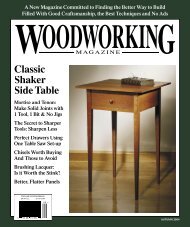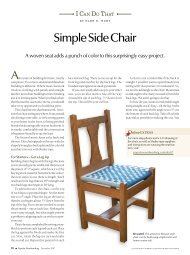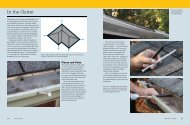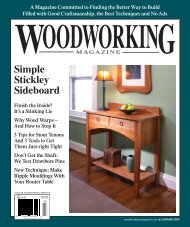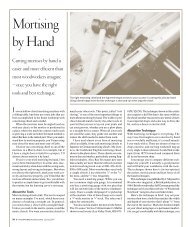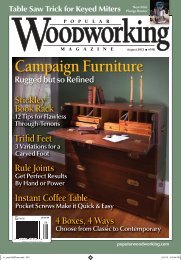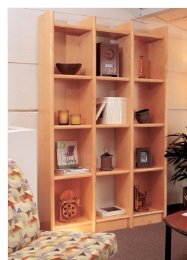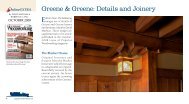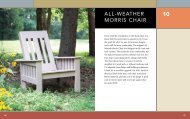Popular Woodworking Magazine April 2011 #189
Popular Woodworking Magazine April 2011 #189
Popular Woodworking Magazine April 2011 #189
You also want an ePaper? Increase the reach of your titles
YUMPU automatically turns print PDFs into web optimized ePapers that Google loves.
A R T S & M Y S T E R I E S<br />
BY BOB ROZAIESKI & WILBUR PAN<br />
Separated<br />
At Birth<br />
Western and Eastern<br />
tools might not be as<br />
different as you think.<br />
At first glance, Japanese woodworking<br />
tools and techniques seem like<br />
the platypus of the woodworking world.<br />
Beginning in the Edo period in the early<br />
1600s, Japan isolated itself from the<br />
rest of the world, especially the West. A<br />
policy of Sakoku meant that no foreigner<br />
could enter Japan and no Japanese could<br />
leave the country – under penalty of<br />
death in either case. This policy continued<br />
for more than 200 years until<br />
the mid 1800s, when Commodore Matthew<br />
Perry forced the opening of Japan<br />
to the West.<br />
As a result, almost all the development<br />
of Western woodworking techniques<br />
and styles from the Jacobean<br />
through the early Victorian periods<br />
were unknown to Japanese woodworkers.<br />
And like the platypus, Japanese<br />
woodworking techniques evolved in<br />
isolation, resulting in a method of work<br />
that was different than in the Western<br />
world. One of the most well-known differences<br />
between Japanese and Western<br />
woodworking techniques is in the<br />
approach to planing wood.<br />
Go West, Young Man<br />
Most of us are familiar with the setup<br />
and use of Western handplanes. There’s<br />
a stock or body made of wood or metal,<br />
a bed or frog to support the iron, also<br />
made of wood or metal, a lever cap or<br />
East meets West. While the differences between Western and Japanese planes are fairly obvious,<br />
their initially hidden similarities might intrigue you.<br />
wedge to hold the iron in place, and<br />
possibly a tote and knob (though some<br />
Western planes lack these). The planes<br />
are pushed away from the body in use,<br />
and the power comes from the legs and<br />
the transfer of weight from the back foot<br />
to the front foot.<br />
The sole of a Western plane is one<br />
flat surface from toe to heel. The iron<br />
projects below the plane of the sole and<br />
establishes the depth of cut. Western<br />
planes also vary in length depending<br />
on their intended purpose. The sole of<br />
the plane acts as a reference surface.<br />
As a result, the longer and fl atter the<br />
plane’s sole, the flatter the resulting<br />
board will be.<br />
Roughing planes such as the fore<br />
or jack plane are of a middling length<br />
(15"-18") in order to be light enough to<br />
rapidly remove material by taking thick<br />
shavings, but also long enough to begin<br />
flattening the board. Surface-refining<br />
planes such as the try or jointer plane<br />
are longer (22"-24") in order to ride<br />
the remaining high spots in the board<br />
and bring it to final flatness. Finishing<br />
planes such as the smooth plane, on the<br />
other hand, are short so that they can<br />
easily tackle localized areas of tough or<br />
reversing grain that remain after using<br />
the try plane.<br />
In use, one puts weight over only<br />
the toe of the plane at the start of the<br />
stroke. As the area of the sole behind the<br />
mouth begins to make full contact with<br />
the board being planed, the weight is<br />
gradually transferred to the back hand.<br />
Once the plane is entirely on the board,<br />
the majority of the weight is on the rear<br />
of the plane. At this point, the front hand<br />
serves only to help steer the toe and<br />
keep the iron in the cut. Most of the<br />
planing force comes from behind the<br />
iron once the entire sole is in contact<br />
with the wood.<br />
This transfer of weight makes the<br />
length of the plane behind the iron an<br />
important factor when using a plane<br />
for flattening and straightening faces<br />
and edges. As the plane begins to cut at<br />
the start of the stroke, the iron removes<br />
wood, making the area of the board<br />
behind the iron lower than the area in<br />
22 ■ POPULAR WOODWORKING MAGAZINE <strong>April</strong> <strong>2011</strong> PHOTOS BY THE AUTHORS; ILLUSTRATIONS BY MARY JANE FAVORITE
Most pressure<br />
here<br />
Minimum pressure<br />
here<br />
Minimum pressure<br />
here<br />
Most pressure<br />
here<br />
Down in front. Pressure is over the toe of the plane at the beginning of the cut. The<br />
area of the sole behind the mouth is not in contact with the board.<br />
Going up. Pressure transfers to the rear of the plane once<br />
enough of the sole behind the mouth is over the board. The<br />
toe then tips up off the work.<br />
front of the iron. At this point, the back<br />
of the plane is not in contact with the<br />
board at all. After the transfer of weight,<br />
the heel of the plane becomes the plane’s<br />
reference surface and the toe rides above<br />
the board at a very slight angle.<br />
In a Western plane, the area of the<br />
sole behind the iron provides the reference<br />
for the majority of the cut. So<br />
it makes sense that Western planes<br />
designed for flattening and straightening,<br />
i.e. try planes and long jointer<br />
planes, are longer behind the mouth<br />
of the plane. The longer and flatter the<br />
sole is behind the iron, the flatter and<br />
straighter the resulting surface will be,<br />
because the longer surface will span the<br />
high spots in the board.<br />
Enter the Dragon<br />
As mentioned before, Japanese woodworking<br />
techniques developed in isolation<br />
from the Western world, and<br />
one result of that is a much different<br />
approach in the types of planes used to<br />
mill and flatten stock. Unlike the Western<br />
woodworking plane arsenal, where<br />
a somewhat long fore plane is used to<br />
initially flatten a board, followed by a<br />
longer try plane for flattening, then finished<br />
with a short smoothing plane to<br />
clean up the surface, the lengths of Japanese<br />
planes for these tasks are all nearly<br />
the same length – about 10 1 ⁄ 2" or so.<br />
What allows these planes to accomplish<br />
the same tasks – despite this obvious<br />
difference – are variations in the setup<br />
of the blade and mouth of the plane, and<br />
a variation in the sole configuration of<br />
a Japanese plane.<br />
The sole of a Japanese plane is different<br />
from a Western plane. On a Japanese<br />
plane, the sole contacts the board at only<br />
two points, and there are two different<br />
setups with this method, depending<br />
Balancing act. The iron acts as a fulcrum or pivot point because the sole is flat. At the start of the<br />
cut, the toe is down and the heel is up (left). Once the weight transfer is complete, the heel is<br />
down and the toe is up, as shown by the tissue paper slipped under the toe (right).<br />
on the task at hand. These days, most<br />
Japanese planes are used as smoothers,<br />
and if a Japanese plane is being used as<br />
such, the sole of the plane contacts the<br />
workpiece only at a narrow area at the<br />
front of the plane, and at another narrow<br />
area immediately in front of the mouth.<br />
The sole is relieved with a very shallow<br />
hollow between these two points, as is<br />
the area behind the mouth.<br />
In use, the Japanese plane is placed<br />
at the end of the board away from the<br />
woodworker, with arms extended.<br />
Downward pressure is placed on the<br />
front of the plane. As the plane is pulled,<br />
the downward pressure does not transition<br />
from the front of the plane to the<br />
rear as it would for a Western plane.<br />
Instead, the downward pressure stays<br />
constant from the beginning to the end<br />
of the stroke, so there is no shift in reference<br />
during the planing stroke, unlike<br />
the shift from front to back when using<br />
a Western plane.<br />
If a Japanese plane is being used to<br />
true a surface or an edge, however, the<br />
sole is set up differently. Instead of having<br />
areas at the front of the plane and<br />
the area in front of the mouth touching<br />
Two points of contact. In the most common<br />
configuration of a Japanese plane, the sole<br />
is slightly relieved so that there are only two<br />
points where the sole of the plane contacts<br />
the wood: at the front of the plane and immediately<br />
in front of the mouth. The relief is on<br />
the order of 1 ⁄ 64" or so, and is exaggerated in<br />
the drawing for clarity.<br />
Two points of contact, take two. Japanese<br />
planes set up for truing a board are set up so<br />
that only the very front and back of the sole<br />
contacts the wood, and the blade is set so that<br />
it is in line with those points of contact. Again,<br />
the relief is just about 1 ⁄ 64", and is exaggerated<br />
in the drawing for clarity.<br />
the board, a Japanese plane set up for<br />
truing a surface has two areas on the<br />
front and back of the plane touching the<br />
surface, with the sole relieved between<br />
these two points, and the blade set so<br />
popularwoodworking.com ■ 23
A R T S & M Y S T E R I E S<br />
that the cutting edge is in line with those<br />
two touch areas.<br />
This plane is pulled in the same way<br />
as other Japanese planes, with downward<br />
pressure throughout the stroke,<br />
but because of the geometry of the setup,<br />
the entire length of the plane can be used<br />
as a reference to flatten the board.<br />
The Japanese equivalent of a scrub<br />
plane, called an ara-shiko kanna, shares<br />
many features with its Western equivalent.<br />
Its primary job is to quickly and<br />
efficiently remove wood to take a roughsawn<br />
board to a flatter state, so it has a<br />
blade with a fairly pronounced camber,<br />
and a wide mouth and throat to allow<br />
thick shavings to pass through. Like<br />
a Japanese smoother, the sole of this<br />
plane is set up to touch the board at only<br />
two points at the front of the plane and<br />
immediately in front of the mouth.<br />
The next step in milling a board is to<br />
true the surface. Here a Japanese woodworker<br />
would use a chū-shiko kanna,<br />
which would be the equivalent of a<br />
Western fore plane. This plane has less<br />
of a camber and a tighter mouth than<br />
the ara-shiko kanna, so it takes thinner<br />
shavings, and ultimately will flatten the<br />
face of the board being milled. A chūshiko<br />
kanna is typically the same length<br />
The long and the short of it. Most Japanese planes are about 10 1 ⁄ 2" long (left). The naga-dai kanna,<br />
the Japanese equivalent of a try plane, is the exception to this rule, being about 15"-16" long (right).<br />
as the ara-shiko kanna, but because this<br />
plane is used to true up a surface, the<br />
sole of this plane is set up so that the<br />
front and back of the soles touch, with<br />
the cutting edge of the blade set in line<br />
with those two surfaces.<br />
Of course, the longer the plane, the<br />
easier it would be to flatten an edge, and<br />
there are longer Japanese planes than<br />
the usual 10 1 ⁄ 2"-long Japanese planes<br />
mentioned so far. These planes are<br />
called naga-dai kanna, and are usually<br />
about 15"-16" long, and serve the same<br />
purpose as a Western try plane. Like the<br />
chū-shiko kanna, these planes are set up<br />
with the front and back ends of the plane<br />
touching the workpiece and the cutting<br />
edge in line with these areas. Again, the<br />
entire length of the plane is used as a<br />
reference for planing. The added length<br />
certainly would help with truing and<br />
flattening longer boards.<br />
identical lengths of reference for flattening<br />
boards Does this mean anything<br />
Is this part of the Zen of working wood<br />
by hand Did the hand-tool gods have<br />
some kind of divine intervention during<br />
the design of these tools Maybe.<br />
On the other hand, perhaps it’s nothing<br />
more than a confirmation that physics<br />
works. The mechanics of flattening<br />
a board or edge should be the same<br />
regardless of where in the world you<br />
are, and maybe it’s us woodworkers,<br />
perhaps misguidedly, who are often<br />
on the lookout for the differences in<br />
the way we work, when we should be<br />
looking for similarities and common<br />
ground, instead. PWM<br />
Bob hosts the popular hand-tool podcast at the<br />
Logan Cabinet Shoppe (logancabinetshoppe.com).<br />
Wilbur lives in New Jersey and writes about Japanese<br />
woodworking tools on his blog “giant Cypress”<br />
at giantcypress.net.<br />
Separated at birth When the reference<br />
lengths of the chū-shiko kanna and a fore<br />
plane are compared side by side, they are<br />
nearly identical in length. The same is true for<br />
a naga-dai kanna and a try plane.<br />
Coincidence or Fate<br />
While the setup (flat sole vs. hollowed<br />
sole) and use (push vs. pull) of Western<br />
and Japanese planes differ considerably,<br />
it’s interesting to note that the lengths<br />
of the reference area of each plane are<br />
almost identical. The length of the sole<br />
behind the mouth on a Western fore<br />
plane, for example, is very similar to the<br />
length of a Japanese chū-shiko kanna set<br />
up for flattening. Similarly, the length of<br />
the sole behind the mouth on a Western<br />
try plane is very similar to the length<br />
of a Japanese naga-dai kanna set up for<br />
flattening.<br />
This is intriguing. How is it that two<br />
completely isolated methods of woodworking<br />
evolved to come up with nearly<br />
u<br />
Go Online FOR MORE …<br />
For links to all these online extras, go to:<br />
u popularwoodworking.com/apr11<br />
VIDEO: See Wilbur Pan explain how to<br />
true a Japanese plane’s sole.<br />
BLOG: Visit the Logan Cabinet Shoppe<br />
and view hand-tool podcasts.<br />
BLOG: Wilbur’s blog, “giant Cypress,”<br />
often discusses Japanese tools.<br />
TO BUY: “Japanese <strong>Woodworking</strong> Tools:<br />
Their Tradition, Spirit, and Use” by<br />
Toshio Odate.<br />
IN OUR STORE: “The Care and Use of<br />
Japanese <strong>Woodworking</strong> Tools.”<br />
Our products are available online at:<br />
u Shop<strong>Woodworking</strong>.com<br />
24 ■ POPULAR WOODWORKING MAGAZINE <strong>April</strong> <strong>2011</strong>



